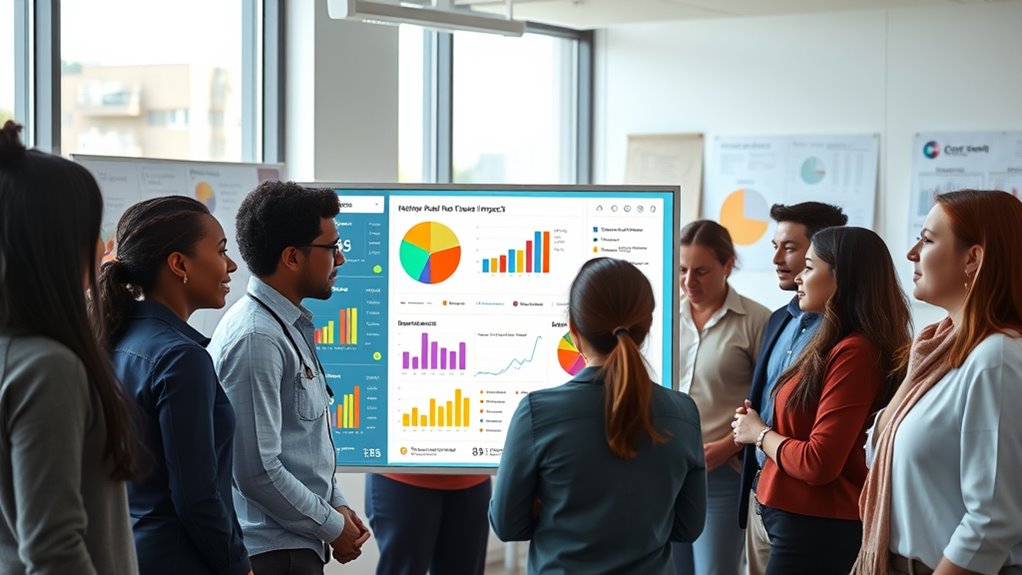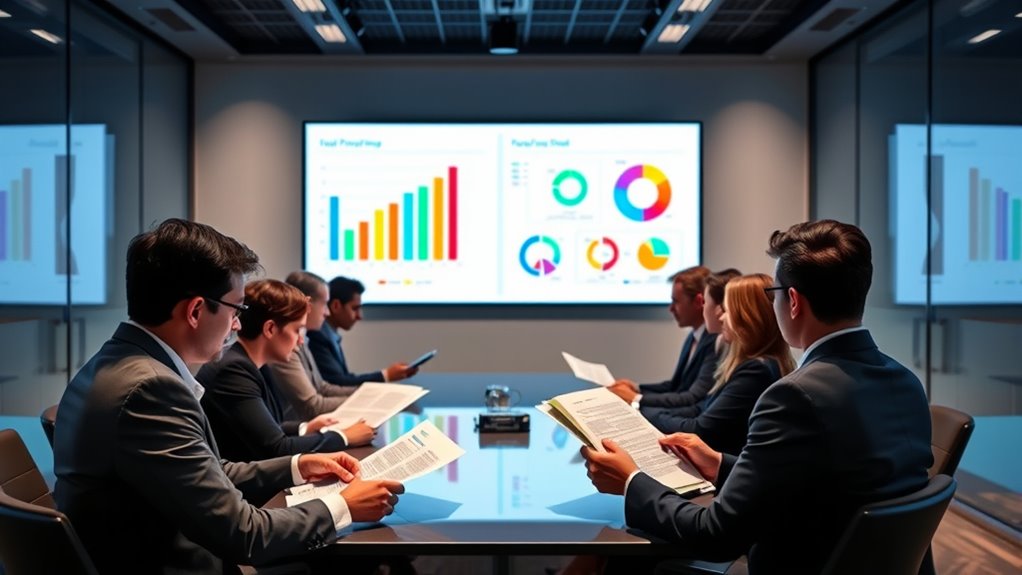To measure your charity’s impact effectively, focus on key metrics like program outcomes, community engagement, and participant well-being. Track financial efficiency through fundraising ROI and overhead ratios, ensuring resource allocation supports your mission. Gauge supporter retention, engagement, and communication effectiveness to build trust. Donor contributions, volunteer participation, and long-term sustainability are also vital. To deepen your understanding of how to evaluate your impact extensively, there’s more to explore ahead.
Key Takeaways
- Use outcome-based metrics to assess the tangible changes achieved by programs, such as participant well-being or community benefits.
- Measure program effectiveness through indicators like community partnership strength, volunteer engagement, and scalability.
- Track long-term sustainability by evaluating ongoing community impact and the durability of program results.
- Collect and analyze quantitative data, including participation rates and partnership metrics, to demonstrate effectiveness.
- Incorporate stakeholder feedback and impact storytelling to communicate results and validate mission achievement.
Financial Efficiency and Cost Ratios

Understanding financial efficiency and cost ratios is essential because they reveal how well an organization manages its resources. Fundraising efficiency shows how effectively your charity converts fundraising expenses into donations, helping you assess the return on investment for your efforts. Overhead ratios, which compare administrative and fundraising costs to total expenses, indicate how much of your budget goes directly toward programs versus supporting operations. A low overhead ratio suggests your organization is operating efficiently, with most funds directed toward mission-related activities. However, keep in mind that extremely low ratios can raise questions about transparency or capacity. Additionally, analyzing relationship dynamics within your organization can provide insights into team collaboration and overall effectiveness. By analyzing these metrics, you gain insight into your organization’s financial health and transparency, enabling you to make strategic decisions that optimize resource allocation and build donor trust. Understanding financial ratios can help identify areas for improvement and ensure sustainable growth, especially when considering program efficiency and how effectively funds are utilized to achieve mission goals. Moreover, integrating performance metrics can offer a comprehensive view of your charity’s operational success. Recognizing sound design principles can also support the development of clear communication strategies to enhance stakeholder engagement.
Program Effectiveness and Outcomes

Measuring program effectiveness and outcomes is essential because it directly demonstrates how well your organization achieves its mission. You can evaluate success through community partnerships and volunteer training, ensuring these efforts translate into tangible results. Tracking outcomes helps identify which strategies work best and where improvements are needed. Consider factors like participant impact, partnership strength, and volunteer skills development. Use the table below to guide your assessment:
| Metric | Description | Example |
|---|---|---|
| Community partnership ROI | Effectiveness of collaborations in achieving goals | Increased service reach |
| Volunteer training impact | Skill improvements and engagement levels | Better service delivery |
| Participant outcomes | Changes in beneficiary well-being | Improved health or education |
| Program scalability | Ability to expand successful initiatives | New service areas |
| Long-term sustainability | Lasting effects beyond program duration | Continued community benefits |
Additionally, leveraging powerful persuasive words can significantly enhance your communication efforts, making your evaluations more compelling to stakeholders. Incorporating clear performance indicators ensures your assessment remains focused and actionable.
Donor Engagement and Retention

Understanding your donor retention rates helps you see if supporters stay committed over time. Monitoring engagement activity levels reveals how involved your donors are, while evaluating communication effectiveness shows if your messages resonate. Focusing on these points can strengthen your relationships and improve long-term support. Additionally, incorporating digital literacy initiatives for your supporters can enhance their understanding of your mission and foster greater engagement. A deeper understanding of yoga benefits can help tailor your outreach to resonate more effectively. Regularly assessing skincare benefits from your outreach efforts can also reveal areas for improvement and increased impact. Recognizing the role of cultural content in community building can further deepen supporter connections and commitment. Incorporating fundraising technology tools can streamline your processes and provide valuable insights into supporter behavior.
Donor Retention Rates
Donor retention rates are a critical indicator of your organization’s long-term sustainability, reflecting how effectively you engage supporters beyond their initial contribution. To improve these rates, focus on implementing donor retention strategies that foster ongoing relationships. Developing a strong engagement program helps keep donors connected and motivated to continue supporting your cause. Regular communication, personalized updates, and meaningful recognition are essential components of successful retention efforts. By understanding your donors’ preferences and showing appreciation for their ongoing support, you create a sense of trust and loyalty. Remember, retaining donors is often more cost-effective than acquiring new ones. Effective communication strategies that include tailored messaging and timely outreach can significantly boost retention rates. Consistently refining your engagement program development ensures you nurture lasting relationships, ultimately boosting your donor retention rates and strengthening your organization’s future. Incorporating effective sound recording techniques and equipment can also enhance your outreach efforts through compelling multimedia content that resonates with supporters. Additionally, attention to detail in your communication strategies can significantly improve donor satisfaction and loyalty. Engaging supporters with water-themed storytelling or visuals related to your cause could further deepen their emotional connection. Furthermore, understanding local resources and tools, such as regional legal experts or community partners, can help tailor your outreach for better engagement.
Engagement Activity Levels
Maintaining high engagement activity levels is key to turning first-time donors into lifelong supporters. You can boost engagement through targeted digital outreach, keeping your audience informed and involved. Regular updates on social media help build a sense of community, encouraging donors to interact with your content and share your mission. Tracking how often supporters engage with your posts, events, or campaigns offers insight into their commitment. Consistent contact, personalized messages, and interactive content foster stronger relationships, increasing the likelihood of retention. When supporters feel connected and valued, they’re more likely to renew their support and become ambassadors for your cause. Additionally, understanding engagement metrics can help identify the most effective channels for nurturing spiritual energy and inspiring continued involvement. Employing engagement metrics allows organizations to measure the effectiveness of their outreach efforts and adapt strategies accordingly. By prioritizing engagement activity levels, you create a loyal base that sustains your organization long-term.
Communication Effectiveness
How effectively you communicate with supporters directly influences their engagement and likelihood to stay committed. Using storytelling impact, you can convey your organization’s mission in a compelling way that resonates emotionally. Sharing real stories of beneficiaries helps supporters see the tangible results of their donations, fostering a deeper connection. Visual communication plays a crucial role too; impactful images, infographics, and videos capture attention and make complex information easily digestible. When your messaging combines storytelling impact with clear visuals, supporters feel more engaged and confident in your work. Consistent, authentic communication builds trust, encouraging donors to remain involved over the long term. Ultimately, your ability to communicate effectively is a key driver of donor retention and ongoing support.
Impact Metrics Specific to Cause Areas

Impact metrics tailored to specific cause areas recognize that different fields require unique measures to accurately assess success. For example, in education, success might be gauged through improvements in literacy rates or graduation levels, emphasizing tangible outcomes. In contrast, environmental causes may focus on measures like reductions in carbon emissions or habitat restoration progress. Incorporating thematic storytelling helps convey these impacts compellingly within each cause area, making the results more relatable and memorable. Cultural relevance also plays a pivotal role, ensuring that metrics reflect community values and local contexts. By customizing impact metrics, you can better capture the true effect of your efforts and communicate achievements that resonate deeply with stakeholders and the communities you serve.
Transparency and Accountability Measures

Why is transparency essential for building trust and ensuring accountability in impact measurement? It demonstrates your commitment to honesty and helps stakeholders assess your effectiveness. Effective transparency reporting relies on clear, consistent disclosures aligned with established accountability frameworks. To strengthen this, consider these key practices:
- Regularly publish detailed impact reports showing your progress and challenges.
- Use standardized metrics to ensure comparability and credibility.
- Incorporate independent audits to verify data accuracy.
- Engage stakeholders in feedback processes to enhance transparency and trust.
Volunteer and Community Involvement

Building on your efforts to guarantee transparency and accountability, involving volunteers and the community directly strengthens your impact. High volunteer engagement demonstrates your organization’s ability to mobilize support and foster trust. Tracking how many volunteers participate, their retention rates, and the diversity of their involvement offers clear metrics of community interest. Cultivating strong community partnerships enhances your reach and sustainability, showing that your initiatives resonate locally. These collaborations often lead to shared resources and amplified outcomes. Measuring community involvement through participation levels and partnership strength helps you assess the social footprint of your programs. Engaged volunteers and community partners not only extend your capacity but also validate your mission’s relevance, ensuring your work remains rooted in community needs and values.
Growth and Scalability Indicators

Tracking growth and scalability indicators helps you understand how well your programs can expand to reach more communities and sustain over time. Key metrics include:
- Partnership development—how many new collaborations you establish to broaden impact.
- Advocacy effectiveness—measurements of policy changes or awareness campaigns driven by your efforts.
- Program reach—growth in the number of communities served over periods.
- Resource scalability—the ability to increase resources without compromising quality.
Monitoring these indicators reveals your organization’s capacity to grow. Strong partnership development can accelerate expansion, while effective advocacy amplifies your reach. By tracking these metrics, you ensure your programs are scalable and positioned for long-term success, making sure your impact continues to grow sustainably.
Long-term Sustainability and Legacy

To guarantee your organization’s long-term impact, you need to focus on financial stability indicators like steady revenue streams and healthy reserves. Planning for program continuity helps maintain your mission even amid changes, while building endowments secures future funding. By prioritizing these areas, you create a lasting legacy that withstands challenges over time.
Financial Stability Indicators
Evaluating financial stability requires carefully examining indicators that reflect an organization’s long-term sustainability and legacy. To do this effectively, you should consider:
- Reserves and endowments—demonstrating financial cushion for future challenges.
- Revenue diversification—reducing dependence on a single source, like grants or donations.
- Fundraising strategies—their efficiency and ability to generate consistent income.
- Organizational governance—transparent decision-making and strong financial oversight.
These metrics reveal how well the organization manages its resources and plans for the future. A focus on sustainable fundraising strategies and solid governance guarantees the charity remains resilient and capable of fulfilling its mission long-term. Monitoring these indicators helps you gauge whether the organization will sustain its impact over time.
Program Continuity Planning
Ensuring your organization’s programs can continue seamlessly over the long term requires proactive planning and strategic foresight. Program continuity planning involves evaluating potential risks and implementing risk management strategies to mitigate disruptions. You should engage stakeholders early and often, gathering their insights and securing their support for sustainable solutions. By involving community members, partners, and funders, you foster shared ownership and resilience. Regularly reviewing your program’s dependencies and adapting to changing circumstances ensures ongoing relevance and impact. Building strong relationships and maintaining transparent communication are essential for long-term support. Ultimately, effective program continuity planning safeguards your organization’s legacy, helping you deliver consistent value and positive change well into the future.
Endowment and Reserves
Have you considered how establishing an endowment or maintaining reserves can secure your organization’s long-term sustainability? Building an endowment supports ongoing growth and provides a financial cushion for uncertain times. To evaluate your reserves’ effectiveness, consider these key points:
- Endowment Growth: Is your endowment consistently increasing, ensuring future stability?
- Reserve Adequacy: Do your reserves cover at least 3-6 months of operating expenses?
- Investment Strategy: Are your endowment investments aligned with your long-term goals?
- Fund Utilization: Are reserves used strategically, not just as a last resort?
Frequently Asked Questions
How Do Charities Adapt Their Metrics for Emerging or Evolving Issues?
When addressing how charities adapt their metrics for emerging issues, you need to focus on implementing adaptive strategies that allow flexibility. By updating your evaluation frameworks, you incorporate evolving indicators relevant to new challenges. This proactive approach helps you stay aligned with changing realities, guaranteeing your impact measurement remains accurate and meaningful. Regularly reviewing and refining your metrics ensures that your charity effectively responds to and measures success in dynamic environments.
What Role Do Qualitative Impacts Play Alongside Quantitative Data?
You recognize that qualitative impacts are essential alongside quantitative data because qualitative insights provide depth and context to your evaluation. By using narrative evaluation, you can understand personal stories and experiences, revealing how your charity’s work truly affects lives. These insights help you grasp the nuanced significance of your impact, complementing numerical metrics, and enabling a more thorough understanding of your charity’s effectiveness and long-term influence.
How Can Donors Interpret Mixed Results Across Different Impact Metrics?
When you encounter mixed results across impact metrics, focus on qualitative analysis to understand the stories behind the numbers. Use data triangulation by comparing multiple data sources to gain a clearer picture of your charity’s true impact. Recognize that quantitative data shows what changed, while qualitative insights reveal why those changes occurred. This combined approach helps you interpret results more accurately and make informed decisions about your support and future investments.
What Innovative Tools Are Available for Measuring Social Impact Effectively?
You can leverage innovative tools like impact dashboards and data visualization platforms to measure social impact effectively. These tools help you track progress in real-time, identify trends, and communicate results clearly. Impact dashboards consolidate key metrics into visual formats, making complex data easier to interpret. Data visualization enhances your understanding of outcomes, enabling you to make informed decisions and demonstrate your charity’s impact more convincingly to donors and stakeholders.
How Is the Success of a Charity’S Strategic Partnerships Evaluated?
Imagine your charity partners with a local school to boost literacy. To evaluate success, you track partnership outcomes like increased reading scores and engagement levels. You also assess collaboration effectiveness by analyzing communication quality, resource sharing, and joint problem-solving. If these metrics show sustained improvements and smooth cooperation, you can confidently say the partnership is successful, demonstrating its positive impact and strengthening future collaborations.
Conclusion
By focusing on these key metrics, you can truly gauge your charity’s impact and make smarter decisions. Remember, don’t put all your eggs in one basket—balance financial health, program success, and community involvement. Tracking these areas helps you stay transparent and accountable, ensuring your efforts aren’t just a flash in the pan. Keep your eye on the prize, because sustainable change takes time and consistent effort.









